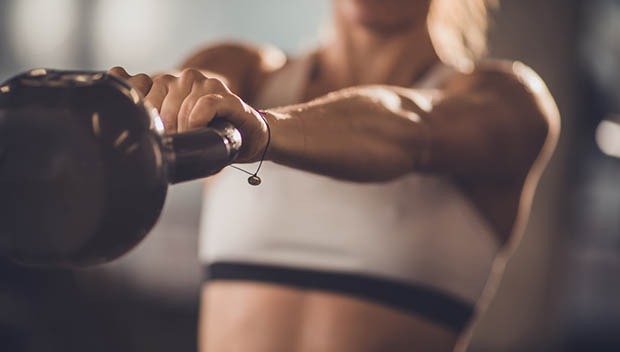
Fitness is all about balance and symmetry, but sometimes achieving that ideal physique is best done with tools that are anything but even. Beat the gym blues by rethinking your strategy and implementing unsteady movements. You'll bolster balance, improve body awareness and zone in on coordination and stability, all while getting in a hefty dose of functional training. Balance training has been shown to help reduce the risk of ligament problems and re-injury. From Bosu ball squats to glider mountain climbers, each of these exercises will work to help you step smart (and steady) in the right direction.
Glider Mountain Climbers
The slick, unsteady surface of gliders on a smooth floor combined with the quick pace of mountain climbers make this a movement designed to get your heart rate up. You'll target your glutes, quads and hamstrings while challenging your balance and coordination. Gliders can help you do that even more effectively by helping you pick up the pace.
Directions
- In a plank position (shoulders stacked over your hands and body in a straight line), place your feet on gliders (one under each foot).
- With your core braced and body steady, lift your toes slightly off the ground and bring your right knee toward your chest. As you bring your right foot back, switch legs, bringing your left knee forward.
- Continue switching off for 30 seconds.
Bosu Ball Squats
Squats are a compound movement that work the posterior chain—hamstrings, quads and glutes. Add the unsteadiness of a Bosu ball into the mix, and you're creating an extra layer of engagement and challenging your core to stay upright and braced while standing on an unsteady surface. In fact, a study in the Journal of Strength and Conditioning Research found that doing exercises on unstable surfaces helped maintain muscle activation in the lower-limbs and trunk. In other words, by using an unstable surface you can engage your muscles to a similar extent even with reduced load.
Directions
- Stand with both feet on the rounded side of the Bosu ball.
- Push your bottom back and lower into a squat. Bring your hands out in front of you for balance or keep them at heart's center.
- Push back up, returning to a standing position. Repeat for 10 reps.
Bodyweight Pistol Squats
When it comes to the pistol squat, control is key. This lower-body movement engages your hips, hamstrings, glutes and squads while forcing you to maximize on mobility. The unilateral nature of this exercise makes it an unsteady challenge since it forces you to balance on the base of one foot. The slow pace of this movement also means your muscles will spend more time under tension.
Directions
- Stand with your feet hip-width apart and shoulders square.
- Lift your right foot a few inches off the ground.
- Bring your arms out in front of you with your palms facing down. Hinge at the hip and lower your body toward the ground, bringing your right foot out in front of you.
- Descend downwards until your right leg is parallel to the floor and your glute is touching your left calf.
- Pause at the bottom of the movement before pressing up. Aim for five reps.
Single-Arm Kettlebell Swing
With a heavy bottom and lighter handle, kettlebells are the epitome of an uneven training tool. Use their weight distribution to your benefit with the classic kettlebell swing. You'll be working your upper and lower body simultaneously, specifically targeting your shoulders, lats, core, hamstrings, glutes and hips.
Directions
- Stand with your feet shoulder-width apart and a kettlebell between your feet.
- Push your bottom back and bend your knees, making sure your back is flat and eyes are up. Your head should be neutral.
- Swing the kettlebell between your legs, finishing a about shoulder height. Make the movement explosive by driving your hips open and allow for a "pop" at the top.
- Allow the kettlebell to come down. That's one rep. Continue to cycle reps together smoothly, aiming for 20.
Single-Leg Bulgarian Split Squat
What better way to round out an uneven workout than to load up one leg at a time? This single-leg take on a traditional lunge is challenging because it requires you to elevate one foot—testing balance and the difficulties of the uneven load.
Directions
- In a lunge position, torso upright and hips square, place one foot on a bench behind you and your other foot a few feet in front. Hold a dumbbell in each hand.
- Flex your knee and hip to descend. Make sure the knee of your front foot doesn't go past the toe.
- At the bottom of the split squat, drive through your heel to push back up to the starting position. Aim for eight reps on each side.
READ THIS NEXT: Challenging, At-Home Workouts You Can Do With Limited Equipment


